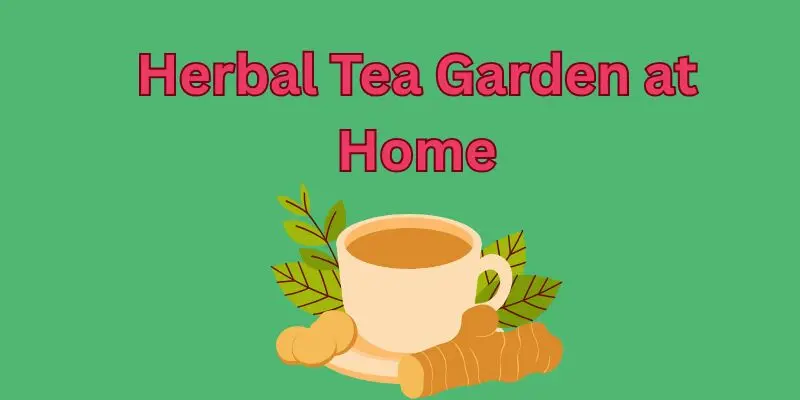Herbal Tea Garden at Home: Grow Your Own Healing, Flavorful Tea Leaves Naturally
Published: 11 May 2025

In a world that moves fast, the simple act of brewing tea can slow you down, grounding you in the present moment. Now imagine brewing that tea from herbs you’ve grown yourself. A herbal tea garden at home is more than just a source of flavor—it’s a retreat, a self-care ritual, and a gateway to better health. Whether you live in an apartment or have a sprawling backyard, you can grow your own calming chamomile, uplifting lemon balm, and invigorating peppermint with just a few containers, sunlight, and care. This guide shows you how.
So, guys, without wasting time, let’s jump into the article to learn Herbal Tea Garden at Home: Grow Your Own Healing, Flavorful Tea Leaves Naturally
Why Start a Herbal Tea Garden at Home?
Health and Wellness Benefits
Herbs used in teas are rich in antioxidants, essential oils, and natural compounds that support immunity, digestion, and emotional balance. Fresh herbs retain more of these benefits than store-bought dried versions.
Emotional Fulfillment and Mental Wellness
Gardening has proven mental health benefits—reducing stress, anxiety, and symptoms of depression. Creating your own herbal tea garden adds purpose, creativity, and joy to your daily routine.
Flavor and Freshness
Homegrown herbs are more aromatic and flavorful. You control the quality, freshness, and growing conditions—no pesticides or preservatives.

Eco-Friendly and Cost-Effective
Skip the packaging, transportation, and cost of store-bought teas. With a home garden, you produce zero-waste, organic herbal infusions on demand.
Best Herbs to Grow for a Tea Garden
You can grow these herbs indoors or outdoors, depending on light and climate:
| Herb | Flavor Profile | Benefits | Growing Tips |
|---|---|---|---|
| Chamomile | Sweet, apple-like | Calming, aids sleep, eases anxiety | Needs full sun, moderate watering |
| Peppermint | Cooling, bold | Aids digestion, relieves headaches | Spreads quickly—best in pots |
| Lemon Balm | Mild lemony | Stress-relief, mood booster | Likes partial shade, moist soil |
| Tulsi (Holy Basil) | Spicy, clove-like | Adaptogen, immunity booster | Thrives in warm, sunny spots |
| Lavender | Floral, soothing | Promotes sleep, calms nerves | Requires lots of sun and dry soil |
| Rosemary | Piney, earthy | Mental clarity, memory aid | Needs well-draining soil and full sun |
| Ginger | Spicy, warming | Digestion, inflammation relief | Needs humidity, filtered light |
| Calendula | Mildly bitter | Skin healing, anti-inflammatory | Prefers full sun and well-drained soil |
How to Set Up Your Herbal Tea Garden
Choose Your Space
- Indoors: Use a sunny windowsill, kitchen shelf, or balcony with at least 4–6 hours of light.
- Outdoors: Balcony, patio, or small raised beds work well.
Containers
- Use pots with drainage holes (terracotta or fabric grow bags work well).
- Size matters: small herbs like thyme need 6″ pots; larger ones like rosemary need at least 12″.
Soil Mix
- Use an organic potting mix with compost and perlite or sand for drainage.
- Avoid garden soil—it’s too dense for containers.
Light Requirements
- Most tea herbs love sun (4–6 hours minimum).
- Use grow lights for indoor setups during winter or in low-light homes.
Watering
- Water when the top inch of soil is dry.
- Mint and lemon balm prefer slightly moist soil; lavender and rosemary prefer drier conditions.
Caring for Your Herbs
Proper care ensures healthy, long-lasting growth:
- Pruning: Regularly pinch back new growth to encourage bushy shape and prevent flowering (which can reduce flavor).
- Feeding: Use organic liquid fertilizers like fish emulsion or compost tea monthly during the growing season.
- Pest Management: Use neem oil or a gentle insecticidal soap to treat aphids, whiteflies, or spider mites.
- Humidity & Air Circulation: Herbs like basil and mint benefit from occasional misting and good airflow to prevent mildew.
Harvesting and Drying Herbs
When to Harvest
- Harvest in the morning after dew dries but before sun gets too intense.
- For most herbs, pick just before flowering for peak flavor and potency.

How to Harvest
- Snip a few inches above the node (where leaves grow) with clean scissors.
- Never harvest more than one-third of the plant at once.
Drying Methods
- Air-drying: Bundle stems with twine and hang upside down in a dark, dry place.
- Oven-drying: Use the lowest setting (below 100°F/38°C) and keep the door slightly open.
- Dehydrator: Great for larger harvests or humid climates.
Storing Herbs
- Store in airtight jars away from light and moisture.
- Label with name and date—most retain quality for 6–12 months.
Blending and Brewing Herbal Teas
Brewing Basics
- Use 1–2 teaspoons of dried herbs (or 1 tablespoon fresh) per cup.
- Steep in hot water (not boiling) for 5–10 minutes, covered to preserve essential oils.
- Strain and enjoy.

Tea Blend Ideas
- Calm & Sleep: Chamomile + Lavender + Lemon Balm
- Digestive Soother: Peppermint + Ginger + Fennel
- Immunity Boost: Tulsi + Rosemary + Calendula
- Focus Blend: Rosemary + Sage + Lemon Verbena
Flavor Enhancers
Add honey, lemon, cinnamon, orange peel, or stevia for extra depth and sweetness.
Emotional & Holistic Benefits of a Tea Garden
- Mindfulness in Daily Routine: Watering, trimming, and brewing become intentional, calming rituals.
- Natural Connection: Even a small garden helps reconnect with seasonal rhythms and living systems.
- Empowerment: Growing your own remedies builds confidence in natural health choices.
- Family & Community: Great activity to share with kids or pass along traditional healing practices.
Troubleshooting Common Problems
| Issue | Cause | Solution |
|---|---|---|
| Yellow Leaves | Overwatering or nutrient deficiency | Let soil dry, use organic fertilizer |
| Leggy Growth | Not enough light | Move to sunnier spot or use grow light |
| Drooping Plants | Root rot or underwatering | Adjust watering, check drainage |
| Pests | Aphids, mites | Spray with neem oil or soap water |
Conclusion:
Creating your own herbal tea garden is a deeply rewarding experience—physically, emotionally, and spiritually. From chamomile’s sleepy comfort to mint’s fresh zing, each herb you grow becomes a part of your wellness toolkit. It’s a garden that nourishes both body and soul. Start small, grow what you love, and sip slowly. Your journey toward natural wellness begins with a single leaf.
References
University of Maryland Medical Center – Provides research-backed guidance on growing and using medicinal herbs like chamomile, peppermint, and lemon balm.
Author Name
M Tierra
Healing Herbal teas.A Complete Guide to Making Delicious, Healthfull Beverage

- Be Respectful
- Stay Relevant
- Stay Positive
- True Feedback
- Encourage Discussion
- Avoid Spamming
- No Fake News
- Don't Copy-Paste
- No Personal Attacks

- Be Respectful
- Stay Relevant
- Stay Positive
- True Feedback
- Encourage Discussion
- Avoid Spamming
- No Fake News
- Don't Copy-Paste
- No Personal Attacks





